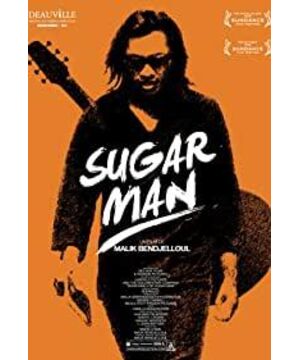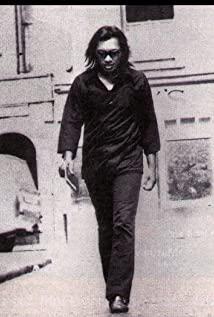For the uniqueness of "Finding Sugar Man", I will mainly talk about three aspects.
1. The way the feature film is told
In this film, the Swedish director Malik Bendjelloul tells the true story of a buried musical genius Rodriguez that has been brought to the attention of the world. It is the progressive narrative structure usually adopted by suspense films, which progresses according to a linear time process, so that this "Citizen Kane"-style exploration will structure the entire film along the time and space dimensions.
This film basically follows the three-act storytelling mode often used in Hollywood feature films, that is, the "build-confrontation-end" method. This structure method is not only applicable to drama films, but also when documentaries also use this kind of structure. It is also very conducive to the development of the content and views to be expressed. Most of the documentaries that have won international awards in recent years are mostly not just because of the depth and passion of the theme, but often because they have adopted this kind of storytelling, taking the audience on an unforgettable journey and telling a gripping story, such as Born into Brothels, Super Size Me, Undefeated, Fahrenheit 9/11 and The Cove )etc.
The film opens with Stephen Segerman driving down a mountain road, singing to the tune of "Sugar Man" playing on the car stereo, and telling us about his nickname The origin of "Old Sugar", the relationship between this title and Rodriguez brings out the narrative motivation of the whole film - to pursue the legendary life of Rodriguez. The legendary way of his shocking death is amazing. What is the life truth of this mysterious man who set himself on fire on stage?
Rodriguez didn't get the attention he deserved when he first debuted, so director Bender asked Raul to lack the real picture information about the protagonist before 1998. According to the director's elaboration in an interview with the media, the director said that he was affected by the animation in 2008. Inspired by the film "Waltzing with Bashir" (whether this film belongs to the category of documentaries, it has caused heated discussions in the academic circles), the animation is used to reproduce the scenes of Rodriguez's past life in Detroit. The footage is interspersed with the director's initial interviews with the two producers of his debut album, Cold Fact, Dennis Coffey and Mike Theodore, in addition to Taking a long shot of the urban poet walking alone in the streets of a small town, the nostalgic tones and the melody of his "Sugar Man" bring the audience back to the days when he first pursued his musical dreams.
Then, the director interviewed the bartenders and bricklayers of the year, who recalled that Rodriguez was like a homeless man, and this view is also confirmed in Dennis Coffey's account, which looks like a It seems to be just a memory of his life at that time, but in fact it is far away from his current lifestyle later in the film. Next, the director went to the home of Steve Rowland, the producer of Rodriguez's second album, Coming From Reality, where he showed Rodriguez to Bender. Guz's photo of the year, and speaking highly of his talent, played what he thought was the saddest song on the "From Reality" album: "Cause." The song is about the anguish of a man who lost his job two weeks before Christmas, and it was the last song Rodriguez recorded with the company that year, and the lyrics of this song really became his Fate prophecy.
The camera moved to Cape Town, South Africa. The director further set up suspense about the reason why his album was spread to distant South Africa. Rodriguez's music, which did not get attention in the United States, was wildly sought after in South Africa. This phenomenon is naturally also It makes the audience even more curious. Rodriguez's influence in South Africa was widespread, but it was initially spread as a pirated copy, and apart from his avatar on the album cover, his loyal fans still knew nothing about him.
Musician William Moller recalled his shock when he heard "I Wonder" for the first time. Rodriguez opened up the wisdom of the people in that special era, those who wanted to escape the industrialized city and pursue themselves. The lyrics, given to anti-establishment connotations by people repressed by the government in South Africa. They took to the streets singing his songs in unison, kicking off a vigorous "freedom movement."
The director interviewed music journalist Craig Bartholomew-Scedon, who recalled that the purpose of everything in the country at the time was to protect apartheid, and this album, liberating the oppressed people, his songs It became the anthem of the "Freedom Movement", and it was because of his music that it led to the music revolution in South Africa, and singers used their voices to sing dissatisfaction with the government. At this point in the interview, I think of his "Establishment Blues" in the picture. The picture is an expansion film of the people's resistance back then, either in black and white or in color, which is full of exciting power.
The director built the suspense again and let "Old Sugar" show up to tell the psychological shock when he heard that Rodriguez was unknown in the United States, which aroused his interest and prompted him to try to get rid of Rodriguez's album. Looking for scant information. Craig Bartholomew-Scedon tells a story he's heard about Rodriguez's suicide, but the witty music that accompanies it seems to suggest it's not Rodriguez's real ending.
In 1996, when the South African distribution company officially released "From Reality", Stephen Sigman was invited to write a booklet for the album. Miu-Scedon happened to see this booklet and volunteered to become a "music detective". His search for the truth begins with where the royalties from Rodriguez's albums go, and he asks the audience this question for the director: If Rodriguez dies, who's going to get his money? How difficult it is to explore such a sensitive topic. Several South African distribution executives have pointed the finger at former Sussex boss Clarence Avant, who released Rodriguez's two albums but dropped him before Christmas. Clarence Avant), in the face of doubts, he emphasized that his company had gone out of business, and showed an attitude of anger. Character truth is revealed only when a person makes a choice under pressure—the greater the pressure, the deeper the reveal, the more truthfully the choice expresses the character's true nature. In this interview, the pursuit of money in human nature is exposed, which is also completely different from the attitude of Rodriguez and his family towards money later in the film.
After the thread was disconnected, the audience's appetite was whetted, but the problem was solved, when Craig Bartholomew-Scedon happened to be listening to "Inner City Blues" by accident Noticing the place name Dearborn, he found in the yellow pages that its location was Detroit, he contacted Mike Theodore, and it turned out that Rodriguez was not dead at all.
Next, Rodriguez's eldest daughter Eva recalled the scene when she saw the report about the search for his father. Under this foreshadowing, the hero Rodriguez finally appeared in the current state of the ongoing tense. In the film, what is unexpected is that what appears in front of the camera is not a cynical person as we imagined, but a gentle and calm person. Since the state of existence is the essence of human existence, when a social environment creates When there is a special existence of man, this manifestation has obvious cultural connotations. He faces the success and failure of life with this spirit of neither humble nor arrogant. Even if he is temporarily abandoned by the music industry, his spirit is still there, and he fully integrates art. The cultivation of self-cultivation is placed in the process of accompanying the daughters growing up, and even expresses the love for the hard and lowly manual labor in the eyes of ordinary people.
The daughter recalled the experience of the whole family accompanying Rodriguez to perform in South Africa on March 2, 1998. The picture was a combination of animation and family DV. The grand occasion edited the documentary of that year's performance. He said, "Thank you for keeping me alive." The fans sang the songs they had already known by heart. The 5,000-strong performance venue was full of passion. Finally, the live concert was on the screen. The screen was upgraded, the audience burst into tears, accompanied by the narration of the voice-over, here, he finally found a "home", this one-of-a-kind concert. So far, the director has combined historical images with real-life images by means of "scenario reproduction", and explained clearly what should be done in the first two scenes. Cause and effect, time and space are just as important for documentaries as for feature films. A random patchwork of events does not make a good documentary, but Bender Jean Lauer has succeeded in achieving a documentary's narrative integrity.
The documentary even has a Hollywood-style happy ending, and for a good documentary, the elements of good storytelling include: compelling characters, a powerful tension meter, and a convincing ending that All three are included in the film. At the end, Rodriguez's eldest daughter, Eva, tied the knot with a security guard at the concert. Rodriguez became a grandfather. We also know that in 1998, he held 6 concerts in South Africa. Tickets All were sold out, of course, the director did not forget to ask the question of royalties again through the mouth of the interviewee, and ended with the song "Rodriguez I'll Slip Away" (Rodriguez I'll Slip Away), which suggested that he would return to ordinary life. From the point of view of his family, the popularity of his South African concert may be a beautiful dream, and life will go on, and they will not be addicted to it. Rodriguez, who is carrying a tool bag, walks to the right side of the screen following the traversing camera, which echoes the scene where he walks to the left side of the screen at the beginning of the film, and seems to be saying goodbye to the audience, and his double-sided life will continue. .
2. Music comes first
From the perspective of the development of film history, the addition of hearing has created the possibility of what Eisenstein called the "synchronization of senses", which positively affects the audience's interpretation of the video content. According to the classification of documentaries by American film theorist David Bordwell, this film belongs to a strategic documentary. In this film, Rodriguez's musical journey is the focus of the performance, so the importance of the soundtrack is self-evident. The music runs through almost the entire film. At the node of each story, music that matches the narrative content is played at the right time, which not only plays a role in setting off the atmosphere and rendering emotions, but also a great contribution to Rodriguez's musical achievements. Big sure.
When the film won the Oscar, not only the film itself aroused the audience's interest in watching the film, but even his music was sung again. Sony's "Legacy" released the film's soundtrack album, which included 14 songs he recorded more than 40 years ago, and the album received a wider distribution than the film.
Similar documentaries, as well as "Another Hey Jude" shot by Japan's NHK, at the end of 1989, in Czechoslovakia after the victory of the Velvet Revolution, the Beatles' famous song "Hey, Jude" can be heard everywhere, and the theme of the film is also : Why was this song so popular with Czechs during the "Prague Spring"?
This "story behind classic song" style documentary is an excellent material for shooting. There are many excellent songs that are widely sung around the world, and many of them have some interesting or interesting happenings in the process of creation and dissemination. Or bizarre stories, I hope documentary creators can make full use of this treasure of material and create more high-quality documentaries.
3. Tribute to real movies
Cinéma vérité (Cinéma vérité) emerged in France in the 1960s, and was represented by the anthropological filmmaker Jean Rouch. Experiment", this film expresses the new concept of documentary, that is, the creators of the documentary should actively participate in the lives of the subjects, prompting them to express their true thoughts, which is obviously different from the Direct Cinema (Direct Cinema) that emerged in the United States at the same time. different.
Although real movies are not a form of documentaries only in recent years, documentaries that continue the style of real movies have become the mainstream trend in the creation of documentaries around the world. In recent years, almost all the films that have attracted the attention of the audience and academic circles are in this form. Such as Errol Morris' "The Thin Blue Line", Oliver Stone's "Kennedy", Morgan Sperlick's "Oversized Me" and Mike Moore's "Fahrenheit 911" and "Capital" Doctrine: A Love Story"... In these films, the director no longer just acts as a purely objective "invisible man", but actively participates in the filming process.
In fact, starting from Flaherty's "rehearsal", the directors of many documentaries have consciously or unconsciously affected the audience's emotional experience during the shooting process. One of the characteristics of real films is to express the creator's ideology and will. This film runs through It is a tribute to Rodriguez, and after the audio was released by Sony Pictures, he won the 85th Academy Award for Best Documentary Feature. Rodriguez's music finally really got the attention of the United States, and his acting in the United States. The career is completely revived, and this is also the manifestation of the effect of the intervention in reality that the real film seeks. What's more, in the credits list at the end of the film, the director's name also appears in the ranks of the actors, which can more directly reflect the director's intention. This way of intervening in the content of the film will definitely be the future trend of documentary creation. one.
Judging from the current development status of documentaries in China and even the world, documentaries are almost at the edge of the industry compared to feature films. The innovation of documentaries in content and form is imminent. "Documentary is the best film", although documentaries have their own Such limitations make it impossible to make major breakthroughs in narrative and montage language. Through the study of documentaries that have won awards at film festivals, we can learn from the experience of successful works, and strive to continuously improve the box office and reputation of documentaries. To achieve the prosperity and development of documentaries.
This article has been included in "China and the World in Documentary" - Proceedings of the First Academic Forum on Colleges and Universities, November 2013.
View more about Searching for Sugar Man reviews








